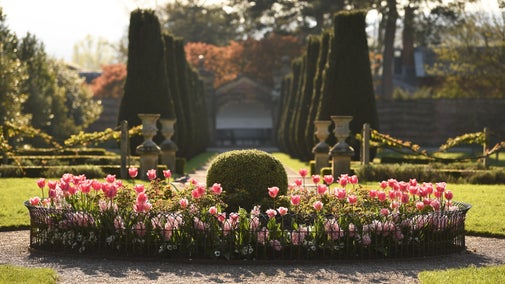
Discover more at Erddig
Find out when Erddig is open, how to get here, the things to see and do and more.

The forces of nature had set in across the house and grounds when Philip Yorke III handed Erddig into our care in 1973. Head Gardener at the time, Mike Snowden, faced a daunting task to uncover and restore this Grade I listed garden. His team set about interpreting old plans, clearing the ground and reading its clues to revive former glories, including the 18th-century walled garden and Victorian parterre.
Three resident sheep and a goat roamed in the overgrown 12.5-acre crumbling walled garden, also home to diseased beech trees, a canal water feature full of ‘black blancmange’ as Mike remembers it, and a ruined boathouse. There was no sign of the formal garden, once the pride of Erddig’s former owners.
Mike wasn’t fazed by this daunting task and while the conservators were desperately trying to save the fragile collection and subsiding house, he began work on restoring the gardens.
– Mike Snowdon, Erddig Head Gardener 1973–80
The restoration was shaped by the garden plans of John Meller, the rich London lawyer who bought Erddig in 1714.
But during research in the archives, the team discovered some of the original plans for the garden from when Joshua Edisbury first commissioned the house in the 1680s. There were references to fruit trees – so fruit was to be a feature of the restoration. Edisbury’s planned garden would have fitted into John Meller’s garden walls 12 times.

After the livestock had gone, the next job was to clear away the ravages of time. With brambles and scrub trees pulled out, the structure of the garden and the enormous scale of the task emerged.
The beech trees were surveyed and found to be rotten and dangerous, so the team felled them and moved the logs to the estate to create homes for myriad wildlife.
Sections of the wall were crumbling and had to be rebuilt – repairs continue today.

Dry weather and frosty days are good for giving clues to former garden designs. The team knew there must have been a formal bedding scheme, because there were hints from shapes in the grass after mowing.
One cold winter’s day, Mike ventured up to the rooftop of Erddig to see if a frosty pattern could be seen. To his delight, a clear outline emerged from the crisp grass below. Mike shouted instructions to a fellow gardener to peg out the shape and the formal bedding scheme of the Victorian parterre was reborn.
It took four years for the house and gardens to be rescued from years of decay. Join our volunteer guides on one of our daily garden tours and explore the impressive walled garden, now restored to its 18th-century formal design.
With rare fruit trees and a National Collection of Ivies, Erddig’s Grade I-listed garden is a very special place, worthy of its earliest plans and the dedication of Mike Snowden’s team.

Find out when Erddig is open, how to get here, the things to see and do and more.

From daffodils in spring to 180 apple varieties in autumn, find out about this 18th-century walled garden and its seasonal activities and highlights.

Find out about the High Sheriff who lived beyond his means when he built Erddig, the rich London lawyer who extended and redecorated it and 240 years of the Yorke family.

Discover the top things to see and do when you visit the parkland. From meandering rivers and an 18th-century water feature to the dramatic escarpment leading to Wat’s Dyke.

Saved from ruin, Erddig is a rare survivor teeming with treasures. From servants’ portraits to fine furnishings, discover the top things to see and do when you visit the house.

Why did the Yorkes remember their staff in pictures and poems? Discover a day in the servants’ lives at Erddig and learn why a housekeeper ended up in court.